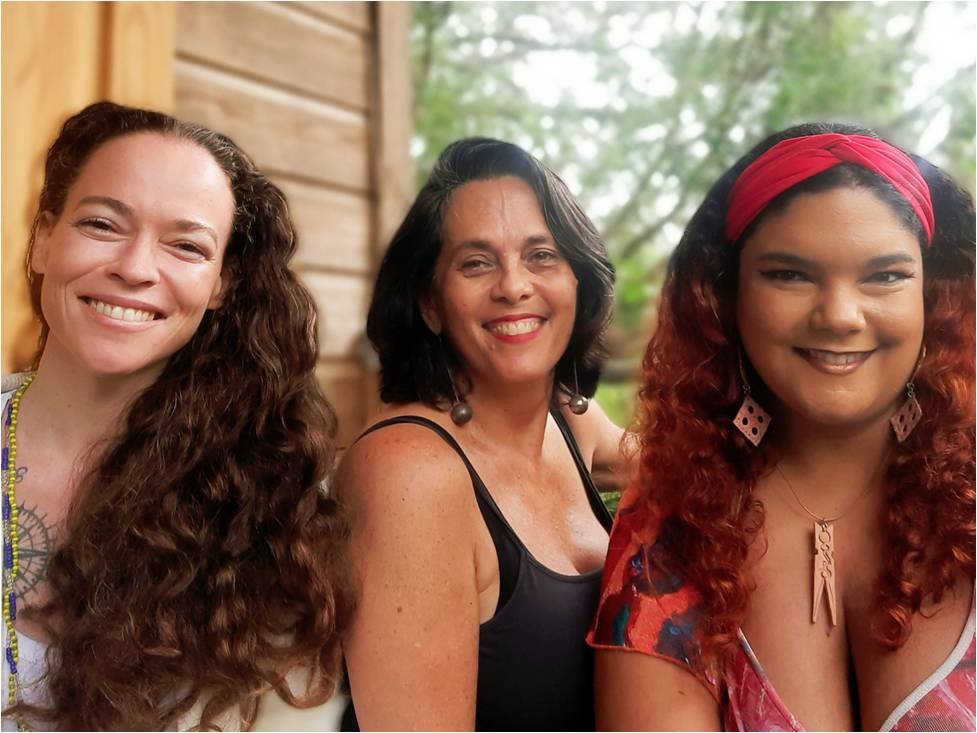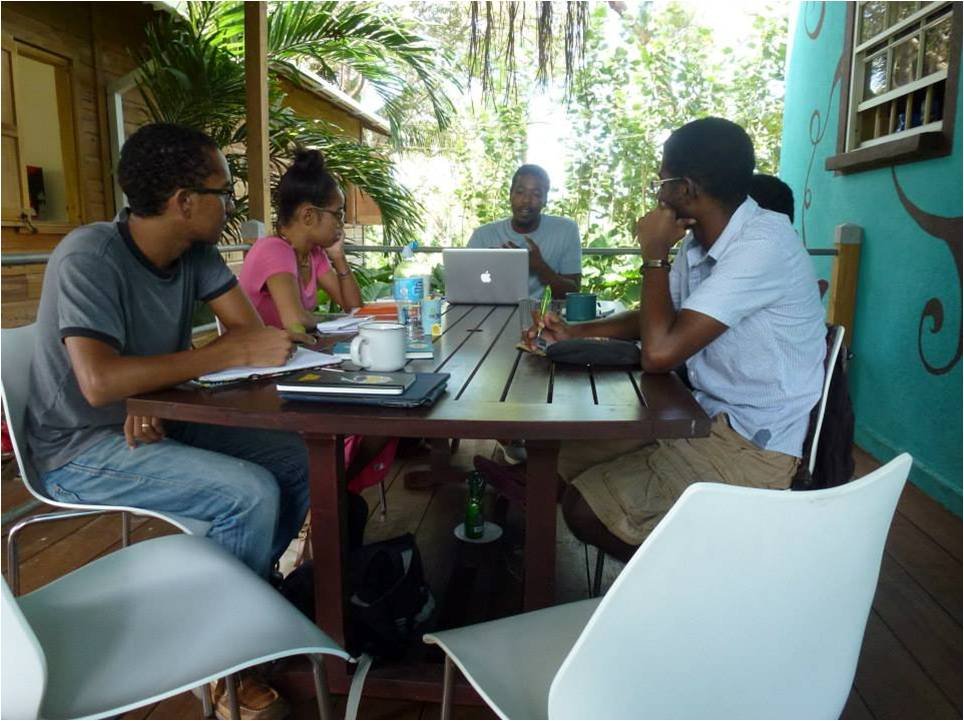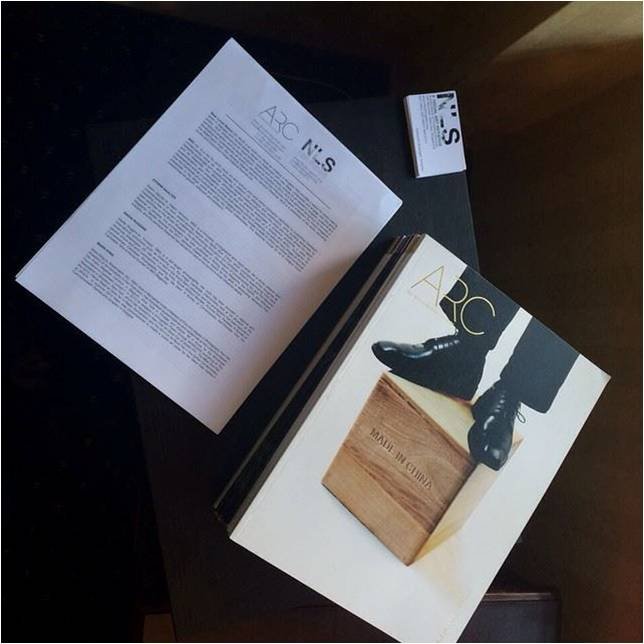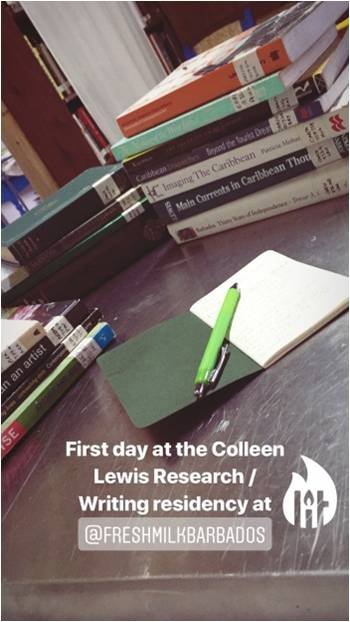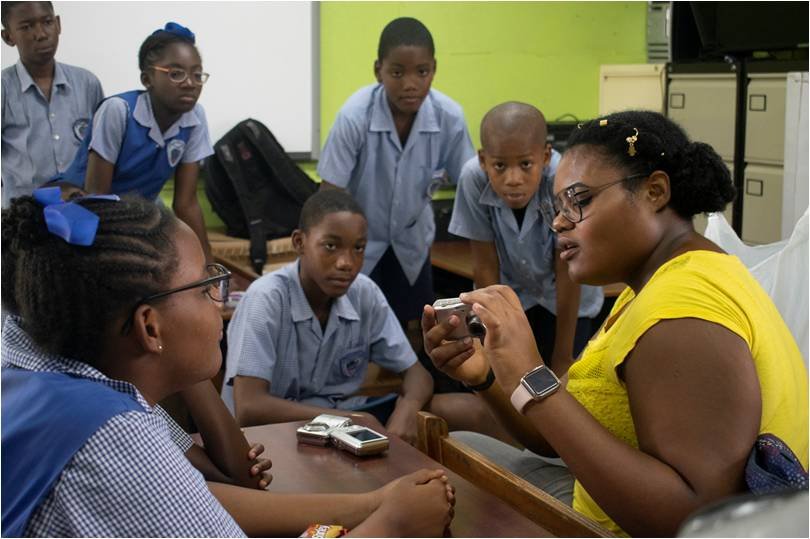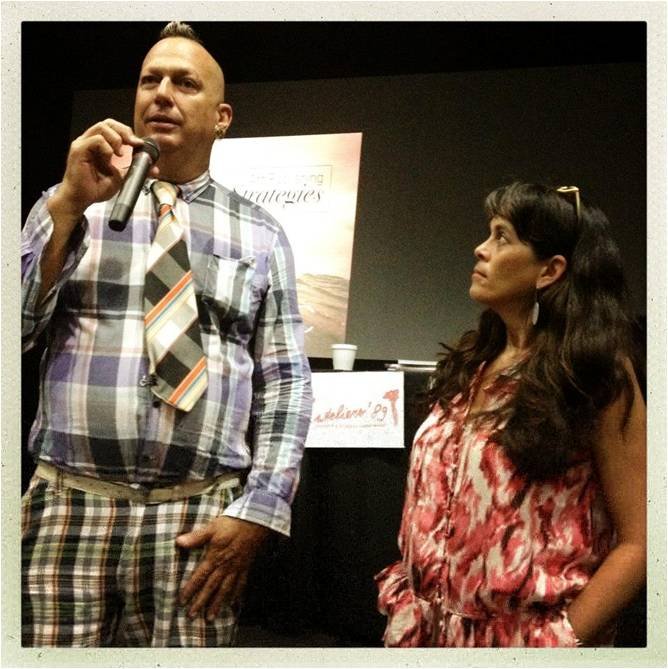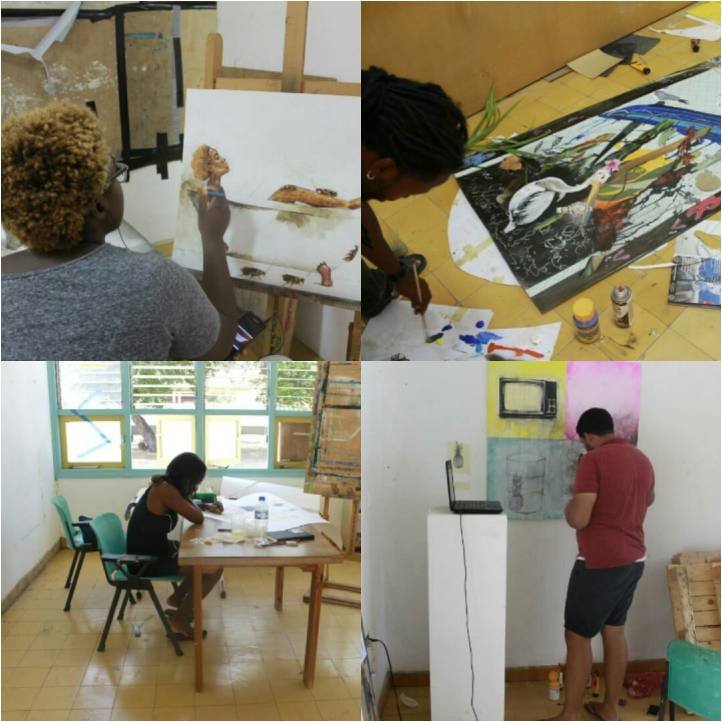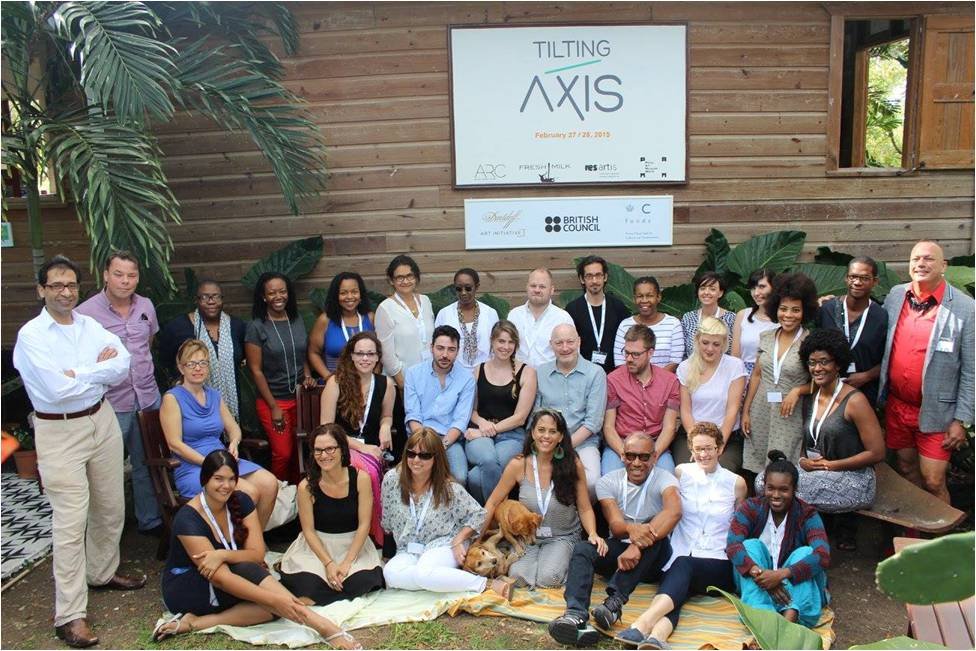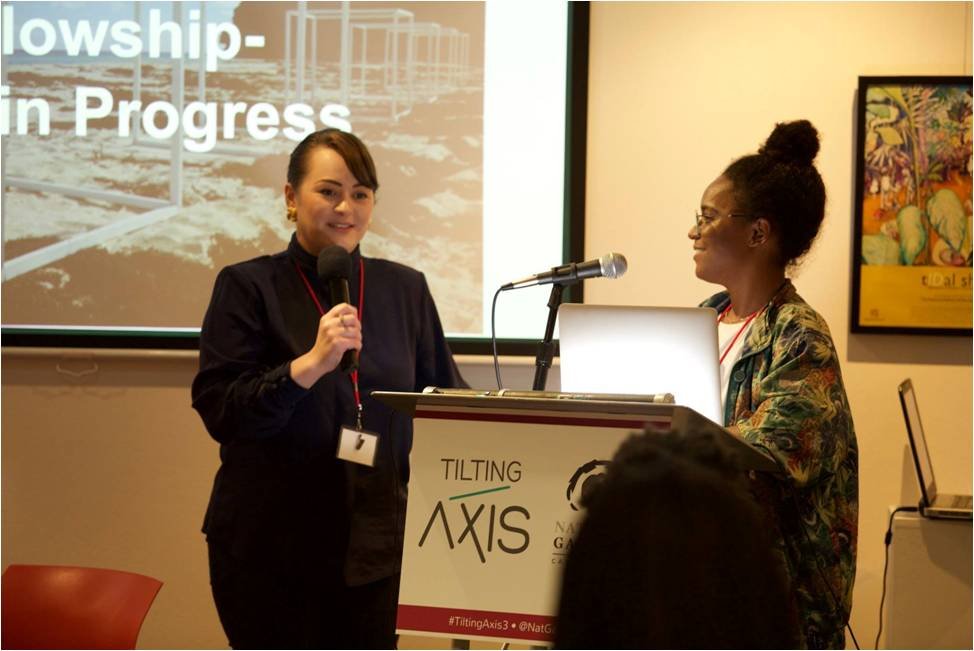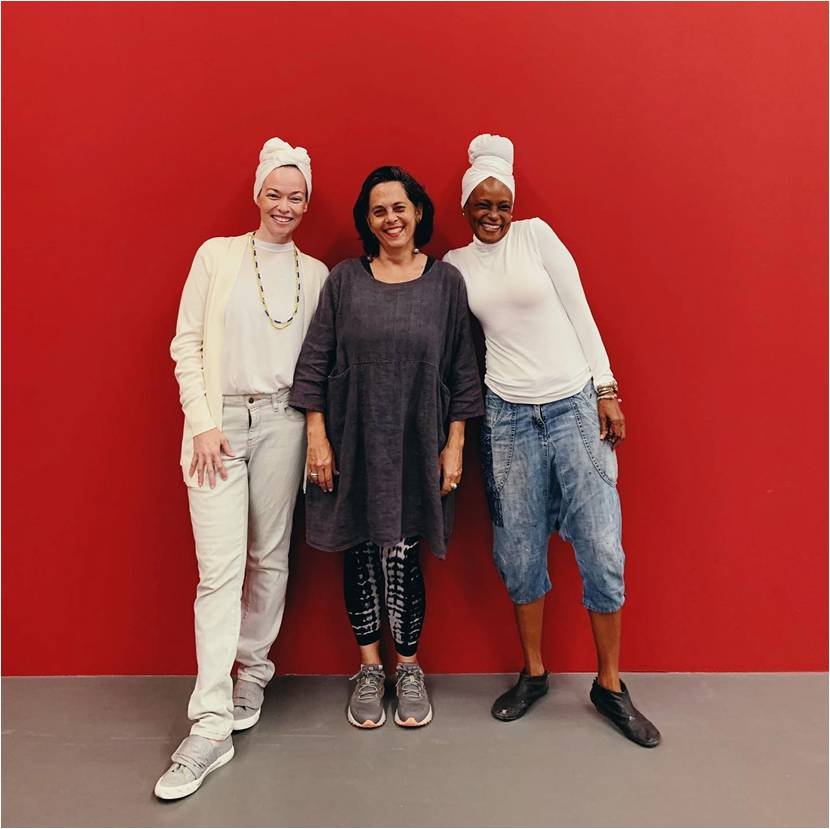Curatorial Multivocality through Caribbean Collaborations: A Conversation with Holly Bynoe, Annalee Davis and Katherine Kennedy, by Natalie McGuire-Batson
–
Published in Faire Mondes.
Curatorial approaches across the Caribbean region have often been vehicles for challenging and dismantling exclusionary global frameworks in visual art engagement. Nestled within this, have been artist-led platforms in the Anglophone Caribbean, such as Fresh Milk, ARC Magazine and Sour Grass, and the collaborative projects that stem from them. Such initiatives have arguably endeavoured to engage diverse archipelagic connections and expand self-determination in Caribbean visual languages, exploring new approaches to curatorship.
ARC Magazine was established in 2010 by Holly Bynoe and Nadia Huggins, who described the publication as focusing on a collection of works by contemporary visual and literary artists practicing in the Caribbean and its Diaspora. Spanning eight print issues and approximately 4,500 online articles written by a variety of Caribbean creatives and thinkers, ARC became a key repository for connecting the vast variety of voices in Caribbean and diasporic cultural landscapes. The launch of such a nucleus coincided with the recent establishment of artist-led initiatives in the Anglophone Caribbean, such as Fresh Milk, which sits in the context of an already somewhat fragmented visual arts sector/milieu in Barbados. It was created out of the perception by founder Annalee Davis that there was no tangible space for local contemporary visual artists, particularly recent graduates of a BFA programme at the Barbados Community College, to expand their art practice and be supported to continue creating art. Davis had a space, a studio attached to her house on a former plantation that is now a dairy farm, which has housed the Fresh Milk platform since its inception. Negotiating imperial remnants in Anglophone Caribbean cultural spaces is a key consideration to foster open exchange and critical inquiry into decolonial practices. Davis’ ongoing vision is to dismantle the gatekeeping that is traditionally associated with plantation sites, and open up the landscape itself for critical inquires through visual arts, archaeology and botany. However, the site of Fresh Milk on a former plantation still held remnants of trauma for some of the local arts community. Despite navigating these sometimes contested terrains, the team behind ARC Magazine and Fresh Milk – Holly Bynoe, Annalee Davis and Katherine Kennedy, began to develop integrated, collaborative programming that sought to better connect contemporary visual arts in the Caribbean at all levels of engagement and discussion.
Caribbean Linked is one of the projects arising out of these collaborations. Established in 2012, it is a Caribbean wide artist residency, bringing together creatives to work in the studios and grounds of Ateliers ’89 in Aruba (the oldest art education organization in the Dutch Caribbean) run by founding director, Elvis Lopez. Tilting Axis has been a second ongoing programme, fuelled by the desire to harness “the collective power to make the arts more visible and sustainable in ways resonating with our lived realities in the Caribbean.”[1]
In the decade that has followed since ARC and Fresh Milk were established, Annalee and Holly, alongside Katherine Kennedy have developed a kind of curatorial multivocality in the transnational collaborative projects that they champion. Curatorial multivocality can be described as the decentralization of authority in developing curatorial frameworks, in favour of approaches that seek to include multiple perspectives on an equal plane. In museology, this practice is articulated through participatory models of curatorship such as Dewdney et. al’s (2013) post critical-museology. Post-critical museology functions on the basis of collaboration with communities, application of work in a transdisciplinary manner, and work that is reflexive, constantly revisiting the accountability of both the practice and the ideas that inform that practice.
In 2020, this ethos of multivocality evolved into the founding of another arts enterprise, Sour Grass, a curatorial agency aiming to provide representation for Caribbean artists through transnational partnerships.
However, at the same time, ARC Magazine shut down its door completely in 2018, existing now only as its publication archive and digital fragments on third party websites. And Fresh Milk has scaled back as an organization, slowing internal programming and visible mainly through discreet projects and partnerships. As someone involved in the development of Fresh Milk programming since 2011, I have experienced first-hand the enormous impact these spaces have on the arts community, as well as the challenges of sustainability. In this context, one filled with the reverent remembrance of organizations coming to a close or scaling back, combined with the optimism of those just beginning, I sat down to have a conversation with Holly, Annalee and Katherine, to reflect on the last decade of their work and discuss the possibilities of the future under their ethos of a multivocal curatorial framework of care.[2]
Natalie McGuire Batson (NMB): Fresh Milk turned 10 this year, and ARC was founded 11 years ago, which just seems incredible. Could you to share some reflections you have on how these platforms have grown and shifted from their inception to today, and if this is the direction you envisioned when you first started out?
Holly Bynoe (HB):
When we were conceptualizing ARC Magazine, one of the first conversations we had was that nothing lasts forever. And that because the Caribbean is such a hard and at times impossible space for creativity and joy, that ARC would be this thing, and when it gets tired, it might
transform into something else, but not necessarily extinguishing. So I was a little bit surprised by the way it played out, blazing in but then fading out. One of the ways in which I tried to process its intention, its mission and what it did accomplish in terms of making and fortifying the network of Caribbean creatives, was through a piece “After Life” that I wrote as a performance. I think that the sort of stopping and or the closing of ARC led to all of these other openings, other possibilities, and it taught me that naivety is a beautiful thing to have. Coming out on the other end, I want one of the biggest lessons learned from that project, to be that the value of community is so essential in creating safe space, like a communicative and somatic space for people to touch each other, to know each other.
Annalee Davis (AD): Fresh Milk became so much more than I ever anticipated it would. I thought that if there were a nurturing space that would allow people to gather, that would add value. I never anticipated that it would have the kind of regional and international reach that it has had. And I also imagined, maybe naively, that at some point, we would have been able to get state subvention to make it sustainable. While there have been some collaborations and state funded grants, what has been disappointing is the inability of state mechanisms in this fiscal environment to more adequately support entities like Fresh Milk. Difficult discussions about scaling back, which we had a couple of years ago were buttressed by the realisation that maybe these things have a short life, and they spawn other things even if the original vision isn’t fully realised. There’s also a kind of a realistic understanding about what a small place like Barbados can actually do for contemporary visual art.
Figure 1 Holly Bynoe, Nadia Huggins and Annalee Davis speaking at the launch of Fresh Milk, August 2011. Photographer: Dondre Trotman. Image Courtesy Fresh Milk.
HB: Just responding to that as well, taking into consideration the sheer number of hours of unpaid labour that we have committed to. You just go because your will is so profound. And because you want to see transformation happen in this space. This is intuitive, and as a woman, I think we have the ability to birth creative projects and squeeze as much as we can from opportunities. In return, the labour is skewered, we end up damaging ourselves and having so much trauma around labour, income savviness, generational wealth and looking at the at the financial responsibilities of life. On reflection, that relationship is healing and getting better, and I feel that we can bring this knowledge to the new projects, so we don’t commit the same atrocities to self and others. It’s really important because there’s a lot of damage due to late stage capitalism that moved into the creative ecologies, as artists are still very undervalued and seen as decorative, especially by the state.
Katherine Kennedy (KK): 10 years ago I would have been 21 when I came back from university, so there’s always been input from three generations, with the three of us working together. We had always been social activists in a lot of senses, but we all entered into that space of activism and advocacy in different ways than we had before. I was probably the most naïve and I was just excited to come back to Barbados and see that there was something happening, because it really – and this has been expressed by a lot of people – has been a source of hope, and it has had an impact. But it’s been a difficult journey. Though reflecting on this impact, a lot of the things that people are building and doing now would not have been possible without this journey. So it’s humbling to even have been a part of that legacy, with everything else that’s going on in the region; to know that we have all been working towards something that has made a difference.
AD: I know, it’s encouraging to think about the relationships that have been formed personally and professionally through these various platforms that have led to other independent projects developed organically by artists. Both Fresh Milk and ARC have developed regional and international interest while it’s been more challenging to do so locally, something we have been addressing within our capacity.
HB: When I when I close my eyes, and I think about everybody mapped out in this extraordinary web of relations, it’s something that I can’t quantify nor put a value on. Not the time or the memories, friendships and the knowledge. So touching back on that word that Katherine said, the legacy, making sure that we honour the things that makes this creative space possible. And while I am in awe of it, I know that was a once in a lifetime opportunity and it would be hard to think that something like that could happen again. It was in time, of time.
It has been and continues to be an organic, easy collaboration all around, with respect and wisdom sharing and reciprocity at the core. I respect and love Katherine and Annalee very much. I feel as though I’ve grown, outgrown, then, grown back in and it feels like a natural ebb and flow dynamic.
Figure 2 Holly Bynoe, Annalee Davis and Katherine Kennedy, 2021. Image Courtesy Katherine Kennedy.
NMB: One of the things that becomes apparent on reflection is the multivocal cultural ecology that has arisen from the work that Fresh Milk and ARC have done. ARC has included many different voices to contribute to articles, particularly on the online platform, but also through the magazines. And Fresh Milk has several projects – Transoceanic Visual Exchange, Fresh Milk Books, the artist residencies, the My Time residencies in particular. So I wanted to inquire about the processes of generating that multivocality? Was it something that just aligned with your own ethos as practitioners? Or was it something that was a kind of conscious cultivation as a curatorial framework or a project based framework?
HB: I’ve always been very humble about our Anglophileness, we occupy such small spaces. So when we sat down to create ARC it was just an implicit understanding that we would try to make this as dynamic, as broad, as inviting, as inclusive as possible. One of the things that we wanted to foster and care for was ourselves and the artists’ communities. Social media and in particular Facebook was emerging and curious in 2010 when we started to ask questions, we were just trying to figure out, what is out there? Who feels like they’re being seen? Who isn’t being seen? Why aren’t you being seen? Nadia and I wanted to create something that was broad, energetic and multifaceted. I thought it was really important to have this comprehensive look in to see what new understandings, new visual realities were arising.
AD: I always felt that Fresh Milk was something that should be driven by multiple people. For example, Transoceanic Visual Exchange and Fresh Milk Books. I thought it was important for people to feel that Fresh Milk was a platform where they could express themselves and develop projects that they wanted to see happen. I also feel that the multigenerational component is really critical. I’ve have been mentored by younger people which is so important for me to feel connected to different generations of voices. It also has been important that Fresh Milk operates out of the site where it’s located. Inspired by the idea of phytoremediation, being on a plantation, believing that spaces can change because of the work that is carried out on those spaces.
Figure 3 The Fresh Milk Books team in 2014: Kwame Slusher, Amanda Haynes, Christian Campbell, Versia Harris, and Tristan Alleyne. Image Courtesy Fresh Milk.
Figure 4 ARC and NLS partnered to stage a group exhibition at (e)merge art fair in Washington. DC, 2014. Image courtesy ARC Magazine.
HB: Collaboration is key. I come from a small space, I had to leave that space, I had to learn myself, learn about myself in a small space to communicate to a bigger space. And that’s when the natural collaboration started, whether it was a person and/or object, and/or nature, I always felt as though I had this internal dialogue with the thing in front of me. I think that transition happened when I started to become more grounded in my photography-making and felt kinship to collaborative practices, this is also deep within my curatorial praxis. It is how I work with artists, it is all very intimate, and its starts with sharing, reactions and then some kind of spontaneous movement where I’m taking in what they’re saying, manifesting or understanding, something changes in them and myself and there’s all this cyclic motion with the movement and elevation of ideas.
Figure 5 Image from the blog entry of local artist in residence Kia Redman, 2019. Image courtesy Fresh Milk.
AD: I think the most critical thing for human beings is to feel a sense of belonging. Many of us might feel a sense of isolation for different reasons, whether it’s around queerness, feeling that you’re on the periphery because of race or class, or because you’re working in the arts. Many of these platforms across the Caribbean have become foster homes for contemporary visual artists. Somebody recently visited Fresh Milk and said they were so happy to be in what felt like a safe space for them. It’s important to create spaces where people can be who they are.
KK: Another thing in terms of multivocality is the blogs that we have asked artists in residence to write; it’s a very simple and tangible thing, but I think it really comes out of the discussions that we’re always having about archiving, and who is telling our own stories. I think people have approached the blog in different ways, but we always try to emphasize that we want it to be a space for somebody to just share their experience and their process, and their journey. I think it’s been a really good starting point to build some kind of an archive around Barbadian artists, Caribbean artists, or artists interested in working within the Caribbean.
Figure 6 2019 artist in residence Kia Redman during her community outreach activities at Workman’s Primary School, Barbados. Photographer: Ethan Knowles. Image Courtesy Fresh Milk.
NMB: So there is this overwhelming evidence of multiple projects on inclusiveness, and yet there still seems to be a lingering critique of Fresh Milk in particular as an exclusionary space. How have you been navigating that in the past in terms of the work that you do?
KK: I think an external perception, and in some ways what we have struggled with internally as well, is the separation of self with organization. I know how we’ve tried to responsibly navigate that, and I think we’re still navigating it. We can’t change every perception, but we need to check in on ourselves and make sure that we’re not in any way feeding into that perception, that we are trying to be as open and inclusive as possible.
NMB: Two of the main regional projects arising from Fresh Milk have been Caribbean Linked and Tilting Axis. Can you start by sharing how Caribbean Linked was conceptualized?
AD: I would say Elvis[3] is one of the colleagues that I have been working with for the longest in the Caribbean. Elvis invited me to teach a drawing course in 1991 at Ateliers ’89 in Aruba. I left my teaching job at the St. Michael’s School in Barbados because I wanted to spend a year moving through the Caribbean and to better understanding my regional community. Elvis invited me back in 2011. And I said, well, I don’t want to come in on my own. I want to bring some people with me. At that time I started to get to know Holly, and wanted to meet John Cox of Popopstudios[4]. Elvis invited Rocio Aranda Alvarez (USA) and Paco Barragan (Spain). And it was in that moment that we thought that what we really need is a Caribbean residency for Caribbean artists.
Figure 7 Elvis Lopez and Annalee Davis at Ateliers ’89 Aruba in 2012. Photographer: John Cox. Image courtesy Annalee Davis.
HB: And it just seemed as though the environment of the Dutch Caribbean was just very different. They had art schools that want to do stuff with us.
KK: Unless you’re there in person, I don’t think you can understand exactly what it’s like to live in a space with these other people from 10 or 12 other Caribbean islands, speaking different languages, learning different things for each other. It all comes together in a very special way that you can’t really anticipate.
Figure 8 Caribbean Linked IV participating artists with Holly Bynoe and Elvis Lopez at Ateliers ’89 Aruba, 2016. Image courtesy Caribbean Linked.
NMB: There definitely seems to be a notion of care coming through these reflections. At larger institutions and museums, there’s this kind of superficial aspect of what care is, it’s almost performative. And really, it’s more about outreach, having people engage during pockets of time and then never having a kind of sustainable relationship after, whereas I find with Caribbean Linked and Tilting Axis, you have that sustainability of connections that arises out of a certain context of care for the artists in the space. So I wanted to ask each of you, which instances stand out to you in particular, that demonstrate this commitment to care?
HB: I think, from the get go, our conversations revolved around this kind of generosity and care, creating something that was generative, that would allow for connections and not something that would only respond to the limitations but listen into the constellations and the configurations of people that were coming into and under our care.
KK: There’s also a dynamic where it isn’t hierarchical, even if the curators and artists are at different levels of their career. There is something that feels very lateral, and everybody’s coming in with the same level of curiosity and hoping to grow from this experience. It’s only three weeks; you’re going on insane amounts of tours, you’re trying to absorb this whole new environment of Aruba, and at the end, there is this tangible exhibition that has to be put out. Everybody comes together every time, even when we always think we’re not going to be able to pull it off. But you do, because everybody supports one another. I think that has been key to the success as to why people want to continue these relationships afterwards.
Figure 9 Jodi Minnis, Ronald Cyrille, Simone Asia and Alex Kelly working in the studios in Ateliers 89 for Caribbean Linked III, 2015. Image courtesy Caribbean Linked.
AD: Also, for me, with Fresh Milk, Caribbean Linked and Tilting Axis, it’s important that we make decisions on Caribbean soil, advocating for what our needs are, driving our own agenda, not have it be prescribed externally. These platforms have become magnets for people across the region and the diaspora to reconnect and grow their network.
HB: I want to call in the memory of the baseboard cracking at Fresh Milk.
AD: Oh my God, yes, the support beam at Fresh Milk broke with the weight of all of the attendees at the first Tilting Axis the in first hour of the meeting!
Figure 10 Participants in the first Tilting Axis meeting at Fresh Milk, 2015. Photographer: Sammy Davis. Image courtesy Fresh Milk.
HB: And with that I just want to address the intimacy of projects like Tilting Axis and Caribbean Linked. So we’re moving from bigger gestures to deeper concerted efforts around setting up a safe space for engagement, a safe space for complex conversations to happen. It gave us a sense of what might be possible with these meetings and gatherings and this convivial method, where you sit with somebody, you look them in the eye, form a circle, have lunch and tea, laugh, squirm, deal with your discomfort and get to the work of knowing. And here we are in the middle of a dairy farm in the middle of Barbados with the foundation breaking from the weight of it all.
AD: We were committed in that initial gathering that this was to be action oriented, and we wanted something to come from this gathering. And that happened. Four more annual gatherings took place and a fellowship programme emerged.
AD: As you know, Caribbean Linked was virtual this year. And while it’s unfortunate not to be in Aruba in person, the group has cohered quite well already so when they get together in person next year, they would have had a head start in terms of getting to know each other Caribbean Linked VI should go very well. The Tilting Axis fellowship is continuing. We’ve just announced our new fellows for this year, and we could potentially have more fellowships happening with different institutions. And I think those are really important.
HB: We’d have to go back to the drawing board and to see what the new needs are now that we’re facing, the climate crisis….how do we become more responsible for our actions, our inaction in the world? Although the five iterations were challenging and tough to produce, the programming grew from strength to strength. I think it’s also really hard to think about institutional partnerships in a region that is collapsing institutionally. It’s really good that we can have this moment of pause and de-growth to question and clarify our intentionality around the Fellowship as well, because that feels like a tangible output as we build guidance for our lives and of course, shoring up the archives.
Figure 11 Tilting Axis 2017 Fellow Nicole Smyth-Johnson in conversation with Tiffany Boyle at Tilting Axis 3 in The Cayman Islands, 2017. Photographer: Roy Wallace. Image courtesy Tilting Axis.
NMB: I wanted to touch on the notion of an archive, as I think that in a way is another legacy of professional projects that come out of these spaces in a way that really, there hasn’t been a centralized archive like it before that has ever been accessible. In accessing information about what has happened, historically, throughout the visual arts in the Caribbean, particularly the Anglophone Caribbean, there can be instances of gatekeeping, there’s a lack of material that still exists, a lot of material gets destroyed. And so I think that one of the ways that these aspects of multivocality and care are sustainable is through this archive, that people can access again and again and begin to engage with in new ways.
AD: This collective work demonstrates that the Caribbean is not an empty slate. In these archives that we are continually building, we demonstrate that people are thinking critically, that many things are happening across this region. This cannot be disputed and our growing archives prove that.
HB: Yes, it’s very deliberate. It’s a very deliberate action to make that recording, and to have it be of the moment, of its time. And because the archive is there, we’re also able to reflect differently on the work because oftentimes, once you move away from projects there is this learning, generation and mourning. So we don’t ever have to mourn that loss because in some way the archive recalls a sound, a feeling and that embedded movement and stillness.
NMB: The nature of Sour Grass is quite a different approach from these previous collaborations and projects we’ve been discussing, because it’s of its insertion into the commercial art world. How the process has been with regards to all these values that we’ve been talking about from both of your practices – the values of curatorial care and multivocality – how has that translated into Sour Grass as an entity that exists in the commercial art world?
AD: With Sour Grass we are thinking about our capacity to generate income, to be sustainable for ourselves and the artists we work with. We see this as an opportunity for our networks to invest in Caribbean artists, to be respectful of the administrative labour and to bring excellence to the table. Sour Grass recognizes that there is growing interest in what’s coming out of the Caribbean, and by entering these international platforms it means they aren’t continually driven by external forces but from within the region.
HB: Sour Grass comes at an interesting time in my life when I am making a more deliberate attempt to think about equity, my (self)care, daily responsibilities to my families and loved ones, and then thinking about the artistic community that have become our family as well – what is our obligation and responsibility to them? To ourselves? For our collaboration with the Atlantic World Art Fair making a virtual gallery space with work of artists whom we respect and admire with other Caribbean women gallerists and entrepreneurs, and some of them working in this field for three generations, is such a profound and deeply rewarding collaboration.
Figure 12 Holly Bynoe, Annalee Davis and Jasmine Thomas-Girvan at the Kunstinstituut Melly, 2021. Image courtesy Jeroen Lavèn.
AD: I do want to throw out two terms that I’ve been mulling around, which is de-growth and slow cultural work. De-growth challenges the constant desire for more, bigger, better, larger–desires that are killing the earth. The idea of slow cultural work, reinforced by COVID, is teaching me to have a more meditative approach to creating, working, and to slowing down. I also think that the Caribbean can be a very, very hard place that requires us to form a harsh exoskeleton when working in the arts, because it is a place that can also drive you mad. It can be a tough place in terms of its value system, one that doesn’t revere its artists, which can in turn contribute to a retreating. But at the end of the day, this is the space to which we are all committed to nurturing and indeed loving, through our collaborative work.
KK: In some ways though, this wouldn’t have been possible in any other kind of space. We wouldn’t have known each other’s work in the same way or done the things we have, even though we have these other challenges that still need to be addressed. But we could have been swallowed up in a metropolitan art scene where we never met, never formed relationships, and never had the opportunity to be this passionate about building something.
Many thanks to Holly Bynoe, Annalee Davis and Katherine Kennedy for their time and insight.
[1] Davis, “Archipelagic Affinities in an Ocean of Shifting Tides” Sea is history: Caribbean Experiences in Contemporary Art, 2016, p.15
[2] Please note that responses have been edited for clarity
[3] Elvis Lopez, founder of Ateliers ’89 in Aruba and key founding partner of Caribbean Linked
[4] Who had opened Popopstudios in The Bahamas
References
Davis, Annalee. “Archipelagic Affinities in an Ocean of Shifting Tides” in Sea is history: Caribbean Experiences in Contemporary Art, Davidoff Art Initiative, 2016
Dewdney, A., Dibosa, D., Walsh, W. Post-Critical Museology: Theory and Practice in the Art Museum, Routledge, 2013
Hadchity, Therese. The Making of a Caribbean Avant-Garde: Postmodernism as Post-nationalism, Purdue University Press, 2020.
McGuire, Natalie. “Kiko Ta Kiko?”, Caribbean Linked, 2015, https://caribbeanlinked.com/editions/caribbean-linked-iii/critical-writing/natalie-mcguire/ last accessed 15/10/2021
Natalie McGuire-Batson’s curatorial work engages community-driven discourse in culture, through research in Caribbean museology. Having completed a BA in History of Art at the University of Leicester and an MA in Museums and Cultural Heritage at the University of Auckland, she is currently a Ph.D. candidate in Cultural Studies at the University of the West Indies Cave Hill with a research focus on Anglophone Caribbean museums and community agency. She is the Curator – Social History and Engagement at the Barbados Museum & Historical Society and serves on several committees, including as Public Relations Officer for ICOM Barbados, and a member of the board for the Barbados National Art Gallery.


